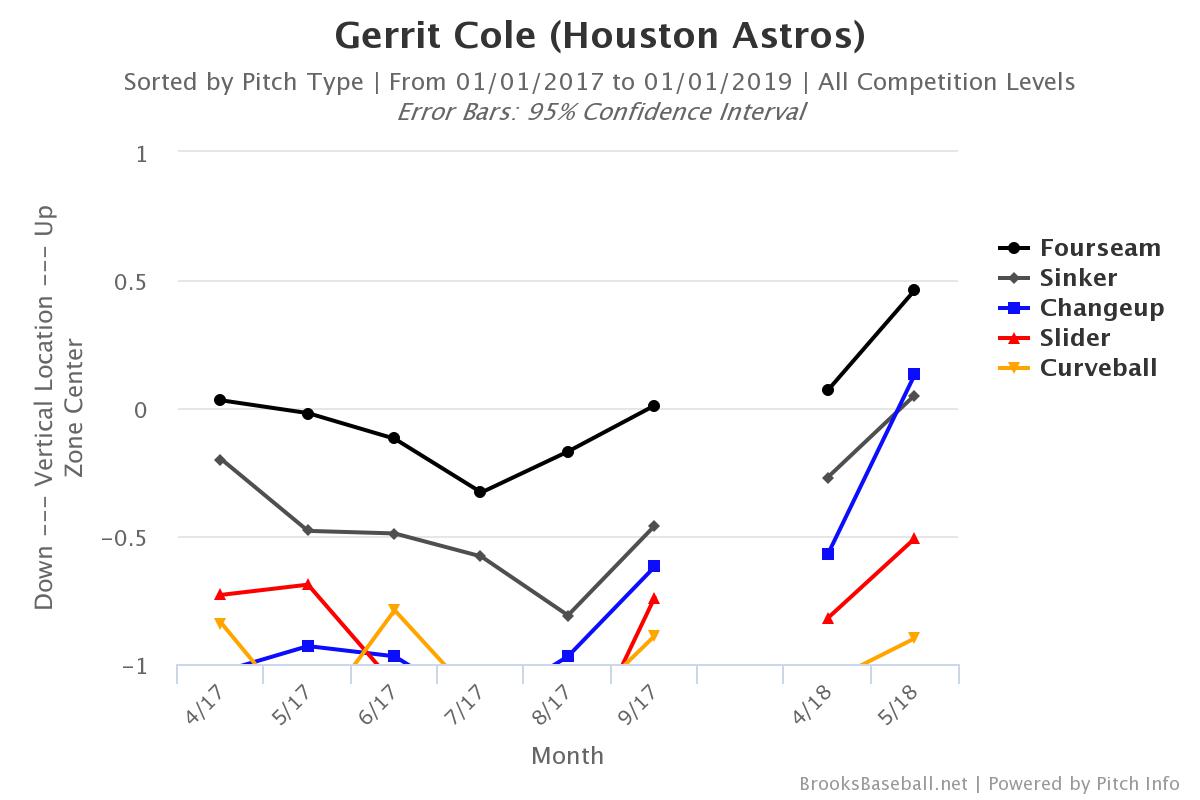It seems like the Houston Astros have a knack for extracting as much production as possible out of a player while paying him pennies on the dollar. We noticed that when news broke of Jose Altuve‘s lucrative extension, and it’s prevalent again with starting pitcher Gerrit Cole.
Not only was he the best starting pitcher in April, but he also continued that roll with his first start in May, which was a complete-game, one-hit shutout with 16 strikeouts. It was the fifth time in seven starts that Cole recorded 11-plus strikeouts.
While he’s making $6.8 million this season, FanGraphs has already pinned his value at $19.9 million entering action Wednesday. That’s insane. As one can imagine, there have been drastic statistical improvements across the board. There’s one change that particularly stands out at this point in the year, though.
The Across-the-Board Improvements
Anytime you get a chance to look at how Cole’s 2018 stats have skyrocketed compared to the past, you gotta do it.
The below table showcases the kind of trajectory he’s on when it comes to ERA, SIERA, strikeout rate (K%), walk rate (BB%), swinging-strike rate (SwStr%), chase rate (O-Swing%), and overall contact rate (Contact%).
His present numbers are obviously huge improvements, but we can actually see a mostly across-the-board upward trend over the past three years. And just to put what he’s done into perspective, his 2.5 fWAR with Houston has already matched his 2016 total and is creeping up on his total from last year (3.1).
Many will point to Cole’s career-low fastball usage (52.9%) along with his current career highs in curveball usage (23.1%) and slider usage (18.0%) as the most interesting change he’s made. It’s hard to argue that, but something else caught my eye that’s just as interesting (and at least somewhat related to these shifts in pitch usage).
A Clear Change in Batted-Ball Profile
Cole was nowhere near the league’s elite when it came to inducing ground balls entering 2018, but it was a rather significant piece to the puzzle for him. Between 2013-17, the right-hander averaged a 47.4% ground-ball rate.
Through 50.2 innings with the Astros, that number has settled in at just 31.9%, which is among the lowest in baseball. Here’s a quick year-by-year snapshot at how his line-drive rate (LD%), ground-ball rate (GB%), fly-ball rate (FB%), soft-hit rate (Soft%), and hard-hit rate (Hard%) compare since 2016.
This year’s hard-hit rate allowed is a few percentage points better than the league average, which is good news. However, if we solely looked at these numbers, there could be a level of concern with the rising fly-ball rate and how prevalent home runs have been in recent years.
But when we look at Cole’s current 0.53 homers-per-nine-innings rate, it’s much better than what it was in 2017 (1.37). What gives? The infield-fly rate, which I conveniently left out.
The 27-year-old has set new career highs for his infield-fly rate in 2016 (11.7%) and 2017 (11.8%). He’s currently on track to set a new high-water mark for the third consecutive season if he’s able to sustain his current 17.1% rate, which is among the best in baseball.
Elevating His Pitches
In addition to changing how he’s using his pitches against opposing hitters, Cole is also placing them much higher in the strike zone. Here’s a look at the vertical location of his pitches since the start of 2017, courtesy of Brooks Baseball.
Cole’s four-seamer has landed higher in the zone over the last month or so than it did at any time last year. This offering has also produced a 54.2% fly-ball rate — the highest for any of his pitches — but it’s accompanied by a 26.9% infield-fly rate. Other pitches that have produced infield flies include his curveball (18.2% fly-ball rate, 100.0% infield-fly rate) and sinker (33.3% fly-ball rate, 33.3% infield-fly rate).
There’s not much in Cole’s numbers that should have you worried. Will he end up regressing a bit? Chances are he’ll struggle at some point. While those batted-ball numbers could potentially raise some eyebrows at first glance, the right-hander’s pitch usage and how he’s controlling his arsenal in the strike zone should help keep things under control.
It didn’t take long for Cole to go from being a dark horse Cy Young candidate to a probable front-runner at the moment. That’s how baseball goes sometimes, and the Astros are once again taking full advantage of the situation.
About Matt Musico
Matt Musico currently manages Chin Music Baseball and contributes to The Sports Daily. His past work has been featured at numberFire, Yahoo! Sports and Bleacher Report. He’s also written a book about how to become a sports blogger. You can sign up for his email newsletter here.
Add The Sports Daily to your Google News Feed!



